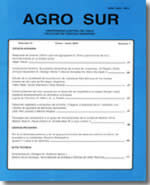Effects of growing area and harvesting season, on yield and quality parameters of juice produced by six carrot genotypes
Main Article Content
Abstract
With the purpose to determine the effect of different cropping places and dates of harvest on the yield and juice quality produced by different carrot genotypes a factorial trial, without irrigation, was done in southern Chile. Four places, three harvesting dates and six genotypes were considered.
Results indicate differences among the genotypes for juice volume, soluble solids (9.0 to 9.8%), pH (6.1 to 6.4), titrable acidity (0.06 to 0.11%), dry matter (11.8 to 12.8%), ashes (0.51 to 0.69%) and color, and also for foliage and root production as a whole, but not found for juice nitrate content (28.6 to 34.1 ppm) and total plany yield, being similar for all genotypes. An important difference between genotypes for bolting susceptibility was found to exist, being higher for T-390 and T-341 (10.9% and 16.0%, respecíively), making them not recomended for the region; the other genotypes (Imperator, Chantenay, Coral II and Line UACH) did not overcome 1%.
Differences for all yield and juice parameters were obtained due to growing places incidence, showing that different quantities and qualities are produced in different areas. Concerning crop yield, these were higher in places with higher summer rainfall, reaching 62 ton/ha of commercial roots (without foliage) at the most southern place (Puerto Octay); at the most northern place (Valdivia) commercial root yield showed to be the lowest (32 ton/ ha, without foliage), being the place that had a lower rainfall.
Plant yield and juice quality were also affected by harvesting dates (every 15 days); being volume and juice color lower at the first crop yielding date, increasing later due to a rainfall produced between the first and second harvest dates. No differences were observed between the second and the third harvest date, except a diminishing in dry matter and soluble solids contents.

